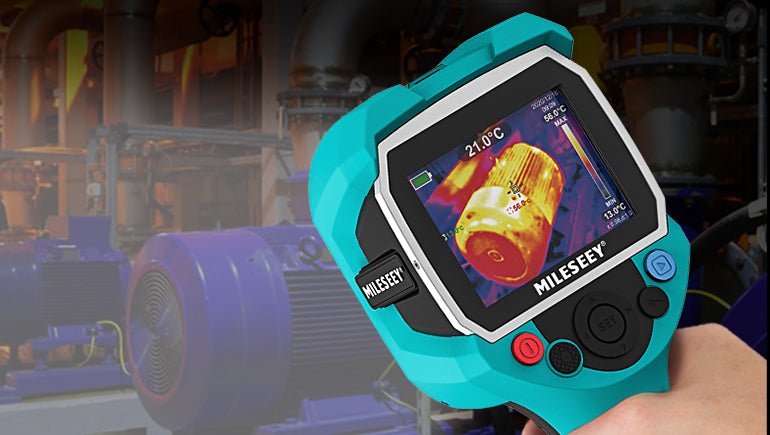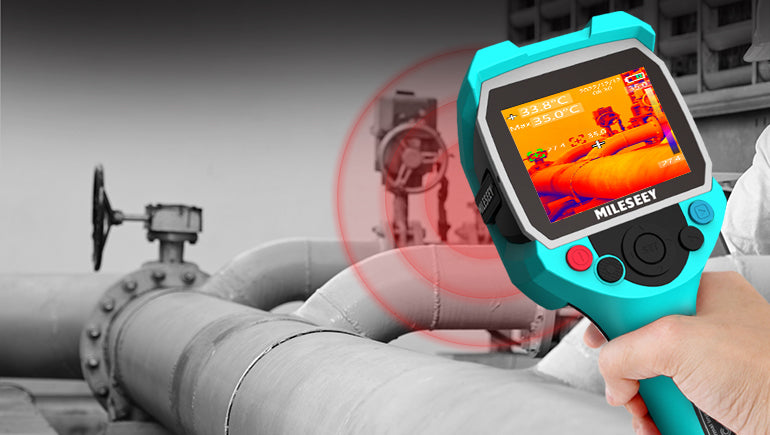An infrared camera can be beneficial for detecting water leaks because it can help determine the leak's source and the amount of damage.
Follow these procedures to detect water leaks with an infrared camera:
- Camera setup:Charge and power the camera: Optimize the camera for leak detection if needed.
- Observe:Check the suspected leak area first: Look for water spots or mold.
- Scan:Scan the suspected leak location using the infrared camera. The camera can detect surface temperature changes that signal a leak.
- Identify the source:Use the camera's visual display to pinpoint the leak after the camera has recognized it. It will help you assess the damage and choose a repair method.
- Repair the leak:After finding the leak's source, fix it immediately to prevent future harm. Depending on the severity, you may need a plumber or leak detection service to fix the leak.
An infrared thermal imaging leak detection camera can help detect water leaks by capturing and displaying thermal images. When there is a water leak, the water can cause a temperature difference in the surrounding area, which an infrared camera can detect and display as a visual image. It enables the user to pinpoint the source of the leak by identifying areas of the image that are significantly warmer or cooler than the surrounding areas.
Using a thermal imaging camera for water leak detection is fast and easy, even if concealed behind walls or under floors. In this article, we will go over how to perform thermal imaging for moisture detection.

What is an Infrared Camera?
An infrared camera is a device that uses infrared radiation to capture and record images. Infrared radiation is electromagnetic radiation with wavelengths longer than visible light.
Mileseey TR256 Infrared Camera, for example, is the most recent version of a handheld thermal imaging camera for water leak detection. There are several important factors to consider when selecting an infrared camera. The most important factors to consider are wavelength range, temperature range, resolution, field of view, lens type, and price. The Mileseey TR120 is a camera that has almost all of these features. Among its features are temperature range, visible light, and a thermal imaging camera with a 3.5-inch display.
How Infrared Camera Water Leak Detection Works
Here are some common parts of an infrared thermal imaging leak detection camera that may be useful for water leak detection:
1. Lens
The lens is the transparent optical component that focuses light onto the detector or image sensor. It is important to have a high-quality lens to produce clear, detailed thermal images.
2. Image sensor
The image sensor is the component that captures the thermal data and converts it into an electrical signal. It is usually located behind the lens and generates a thermal image.
3. Display
The display is the screen on which the thermal image is displayed. It can be either a traditional screen or a heads-up display, which projects the image onto a transparent surface in front of the camera.
4. Controls
Infrared cameras typically have various controls that allow the user to adjust the settings, such as the temperature range, emissivity, and level/span. These controls can help fine-tune the thermal image and make it easier to identify subtle temperature differences.
5. Software
Many infrared cameras come with software that allows the user to analyze and manipulate thermal images. It can include temperature measurement, image annotation, and temperature alarms.
Read More: How to Use Thermal Imaging for Home and Building Inspection

Using Infrared Camera to Detect Water Leaks
To detect water leaks with an infrared camera:
- Begin by ensuring that the infrared camera is properly calibrated and operational.
- Inspect the area where you suspect there is a water leak. Look for areas of the surface that are cooler or warmer than the rest, as these could indicate the presence of a leak.
- Scan the surface with the infrared camera, paying special attention to areas with a temperature difference.
- The infrared camera will generate an image of the inspected surface, with different colors representing different temperatures. Look for areas of the image that are a different color than the rest of the image, as these could indicate the presence of a leak.
- If you suspect a leak, you can use the infrared camera to help you pinpoint the exact location of the leak. You can accomplish this by carefully scanning the surface for areas with significant temperature differences.
- Once you've located the leak, you can use the information provided by the infrared camera to assess the extent of the damage and plan a repair strategy.
Mileseey Thermal Imaging Camera for moisture Detection
Binoculars, also known as binocular telescopes or field glasses, are optical instruments that magnify and clarify distant objects using lenses and prisms. A pair of binoculars' magnification and objective lens diameter are measured, usually indicated by two numbers written on the binoculars.
A 7x50 binocular, for example, has a magnification of 7 and an objective lens diameter of 50 millimeters; an 8x binocular magnifies the image by a factor of 8. The higher the magnification, the more powerful the binoculars and the more detail you can see.
Mileseey products that provide the best thermal imaging camera for water leaks and would be ideal for providing thermal imaging for moisture detection include
- Mileseey TR256 Infrared Camera
- Mileseey TR120E Infrared Camera
- Mileseey TR120 Infrared Camera
- Mileseey TNV10 Infrared Camera
Mileseey has posted all the above Infrared water leak detection equipment for sale on its website.

Frequently Answered Questions (FAQs)
1. How far can the infrared camera see?
They are generally used at closer ranges, often in industrial, medical, or military applications, to detect and diagnose problems or to monitor processes and equipment.
2. How far can a thermal sensor detect?
The detection range of a thermal sensor is determined by several factors, including the type of sensor, its sensitivity, and the ambient temperature and thermal characteristics of the environment in which it is used.
3. What is the difference between infrared cameras and thermal cameras?
Infrared cameras, also known as visible-light thermal cameras, measure the amount of infrared radiation emitted by an object and generate an image based on that data. Thermal cameras, on the other hand, use a detector known as a microbolometer to measure the thermal energy emitted by an object and generate an image based on that data.
Wrapping It Up
Infrared cameras are widely used in various applications, including thermal imaging, night vision, and scientific research. To use an infrared camera, follow these steps:
- First, familiarize yourself with the camera's controls and settings
- Next, choose the appropriate lens for the task at hand
- Turn on the camera and set the appropriate settings
- Point the camera at the object you want to capture and press the shutter button to take a picture
- Review the captured image to see if it meets your needs
- To capture additional images, repeat the process
Mileseey is a high-tech company that combines industrial designs, R&D, manufacturing, and marketing. As the industry's undisputed market share leader in thermal imaging cameras and infrared technology, Mileseey guarantees that every product offers superior functionality.
It offers a wide range of high-quality products, such as thermal imaging cameras for fire services, hunting/night vision, green laser level, and laser measure, among other instruments which can be used by firefighters in the event of a fire outbreak.
Related blogs from Mileseey
Factors to Consider When Buying a Thermal Monocular for Hunting
How to Use Thermal Imaging Cameras for Home and Building Inspection
How to Choose Industrial Infrared Cameras for Power System Inspection
Be the first to know the latest updates, tips, how-tos, exclusive deals, and discounts from Mileseey. Sign up for our newsletter today!






.png?w=800&h=800)




.png?w=800&h=800)























